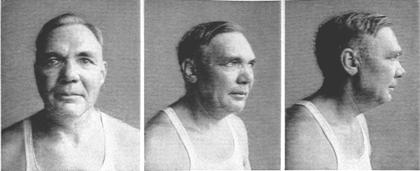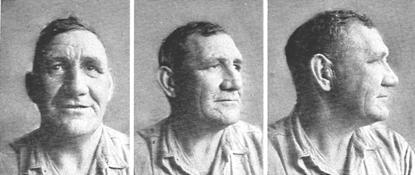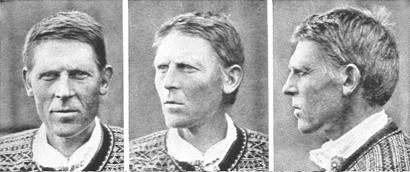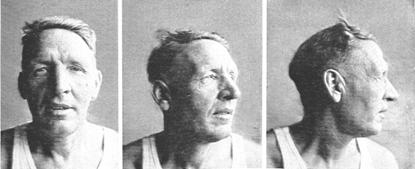|
(Photographic Supplement, Plate 4)
All Upper Palaeolithic survivors may be divided into two general groups (a)
those who have been subjected to reduction in head size and bodily bulk, and
who, have been partially foetalized in the course of the same process; and (b)
those who retain the head size, bodily bulk, and masculinity of features
characterstic of the Pleistocene hunters. Most of the latter group are to be
found in northwestern Europe. Dolichocephalic individuals who recapitulate the
metrical and morphological qualities of the Crô-Magnon and Brünn-Předmost
Aurignacian people are commonest in Scandinavia and in Ireland. In Scandinavia
they are found concentrated along the southern Swedish coast in the neighborhood
of Göteborg, and in the mountains of southwestern Norway.
FIG. 2 (3 views). Another Swede, in this case from Göteborg, a slightly less extreme example of the same type. Swedes of this type are habitually found in association with the sea. Both of these individuals, as well as Fig. 4, were measured and photographed in a Boston shipyard.
FIG. 3 (3 views, from Alette Schreiner, Anthropologische Lokaluntersuchungen in Norge; Valle, Halandsdal, und Eidfjord. Oslo, 1930. #113). This Norwegian from the isolated mountain settlement of Valle in southwestern Norway represents the same basic type as the two men above; his face and mandible, however; are narrower; and his hair ash blond; admixture with Nordics is indicated.
FIG. 4 (3 views). The same conclusion is suggested in reference to this extremely long-faced and golden-haired Swede from Helsingborg. He is, however, much larger in head and face size, much heavier in body build, and heavier in the facial skeleton than any Nordic. The predominant strain is Upper Palaeolithic.
|



